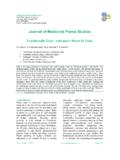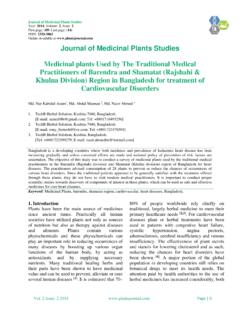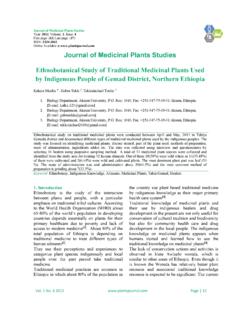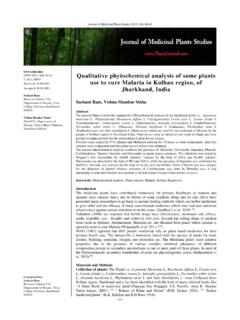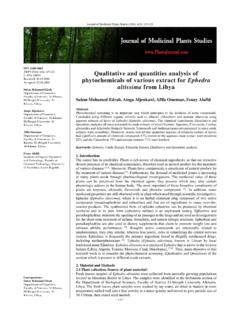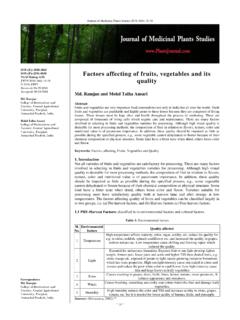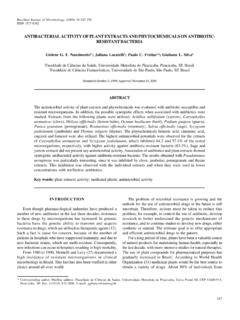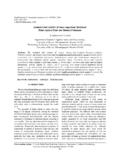Transcription of Journal of Medicinal Plants Studies
1 Journal of Medicinal Plants Studies Year : 2013, Volume : 1, Issue : 1. First page : (7) Last page : (15). ISSN: 2320-3862. Online Available at Journal of Medicinal Plants Studies Traditional and Medicinal Uses of Carica papaya Aravind. G *1, Debjit Bhowmik 1 , Duraivel. S 1, Harish. G 1. 1. Department of Pharmacognosy, Nimra College of Pharmacy, Vijayawada, Andhra Pradesh, India (E-mail: Papaya, botanical name Carica papaya, is an lozenge tropical fruit, often seen in orange-red, yellow-green and yellow-orange hues, with a rich orange pulp. The fruit is not just delicious and healthy, but whole plant parts, fruit, roots, bark, peel, seeds and pulp are also known to have Medicinal properties.)
2 The many benefits of papaya owed due to high content of Vitamins A, B and C, proteolytic enzymes like papain and chymopapain which have antiviral, antifungal and antibacterial properties. Carica papaya can be used for treatment of a numerous diseases like warts, corns, sinuses, eczema, cutaneous tubercles, glandular tumors, blood pressure, dyspepsia, constipation, amenorrhoea, general debility, expel worms and stimulate reproductive organs and many, as a result Carica papaya can be regarded as a Neutraceutical. The present article reviews the pharmacological uses of Carica papaya and side/toxic effects.
3 Carica papaya contains an enzyme known as papain which is present in the bark, leaves and fruit. The milky juice is extracted, dried and used as a chewing gum for digestive problems, toothpaste and meat tenderizers. It also contains many biological active compounds including chymopapain and papain which is the ingredient that aids digestive system, and again used in treatment of arthritis. Keyword: Carica Papaya, Papain, Chymopapain, Neutraceutical 1. Introduction: diabetic heart disease. Papaya lowers high Papaya is a powerhouse of nutrients and is cholesterol levels as it is a good source of fiber.
4 Available throughout the year. It is a rich source of threes powerful antioxidant vitamin C, vitamin Papaya effectively treats and improves all types A and vitamin E; the minerals, magnesium and of digestive and abdominal disorders. It is a potassium; the B vitamin pantothenic acid and medicine for dyspepsia, hyperacidity, dysentery folate and fiber. In addition to all this, it contains and constipation. Papaya helps in the digestion of a digestive enzyme-papaintha effectively treats proteins as it is a rich source of proteolytic causes of trauma, allergies and sports injuries. All enzymes. Even papain-a digestive enzyme found the nutrients of papaya as a whole improve in papaya is extracted, dried as a powder and used cardiovascular system, protect against heart as an aid in digestion.
5 Ripe fruit consumed diseases, heart attacks, strokes and prevent colon regularly helps in habitual constipation. It is also cancer. The fruit is an excellent source of beta reported that papaya prevents premature aging. It carotene that prevents damage caused by free may be that it works because a poor digestion radicals that may cause some forms of cancer. It does not provide enough nutrients to our body. is reported that it helps in the prevention of The fruit is regarded as a remedy for abdominal disorders, The skin of papaya works as a best Vol. 1 No. 1 2013 Page | 7. Journal of Medicinal Plants Studies medicine for wounds.
6 Even you can use the pulp These nutritional values of papaya help to prevent left after extracting the juice from papaya as the oxidation of cholesterol. Papaya is rich in iron poultice on the wounds. The enzymes papain and and calcium; a good source of vitamins A, B and chymopapain and antioxidant nutrients found in G and an excellent source of vitamin C (ascorbic papaya have been found helpful in lowering acid). The extracts of unripe C. papaya contain inflammation and healing burns. That is why terpenoids, alkaloids, flavonoids, carbohydrates, people with diseases( such as asthma, rheumatoid glycosides, saponins, and steroids.)
7 Arthritis, and osteoarthritis) that are worsened by inflammation, find relief as the severity of the Table 1: Papaya, raw Nutritional value per 100 g condition reduces after taking all these nutrients. Energy 163KJ. Papaya contributes to a healthy immune system Sodium 3 mg by increasing your resistance to coughs and colds Potassium 257. Phosphorus 5. because of its vitamin A and C contents. Papaya Magnesium 10. included in your diet ensures a good supply of Iron vitamin A and C that are highly essential for Calcium 24. maintaining a good health. Carica papaya Vitamin C constituents exhibit alkaline combination, as with Folate (vit.
8 B9) 38. borax or potassium carbonate and they have Vitamin B6 Niacin (vit. B3) showed good results in treatment of warts, corns, Riboflavin (vit. sinuses, eczema, cutaneous tubercles and other B2). hardness of the skin, and also injected into Thiamine (vit. indolent glandular tumors to promote their B1) mg absorption. Green fruits of papaya are used to Vitamin A 328. treat high blood pressure, dyspepsia, constipation, Protein Fat amenorrhoea, general debility, expel worms and Dietary fibre stimulate reproductive organs. Sugars Carbohydrates 2. Biological Sources Botanical Name: Carica papaya Family Name: Caricaceae Table 2: Carica papaya is a pack of enzymes Common Name: Papaya, Paw Paw, Kates, Papaw Phytoconstituents Carica papaya part Part Used: Leaves, Fruits, bark, leaves Enzyme Unripe fruit Papain,chymopapain 3.
9 Nutritional Value Carotenoids Fruits The papaya, papaw, or pawpaw is the fruit of the carotene,crytoxanthin plant Carica papaya, the only species in the genus Carposide Roots Carica of the plant family Caricaceae. It is native Glucosinolates Seeds Benzyl isothiocynate, papaya oil to the tropics of the Americas. The papaya is a Minerals Shoots, leaves large, tree-like plant, with a single stem growing Ca, K, Mg,Zn,Mn,Fe from 5 to 10 m (16 to 33 ft) tall, with spirally Monoterpenoids Fruits arranged leaves confined to the top of the trunk. Linalool,4-terpinol The leaves are large, 50 70 cm in diameter, Flavoniods Shoots deeply palmately lobed, with seven lobes.
10 The Myricetin,kaemferol Alkaloids Leaves tree is usually unbranched, unless lopped. The Carpinine,carpaine,vitamin C and E. flowers appear on the axils of the leaves, maturing into large fruit. The fruit is ripe when it These nutritional values of papaya help to prevent feels soft and its skin has attained amber to the oxidation of cholesterol. Papaya is rich in iron orange hue. and calcium; a good source of vitamins A, B and Vol. 1 No. 1 2013 Page | 8. Journal of Medicinal Plants Studies G and an excellent source of vitamin C (ascorbic Leaves acid). The extracts of unripe C. papaya contain Papaya leaf has a numberless of benefits.
